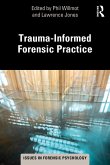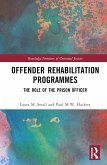The Routledge International Handbook of Forensic Psychology in Secure Settings
Herausgeber: Ireland, Carol; Gredecki, Neil; Fisher, Martin; Ireland, Jane
The Routledge International Handbook of Forensic Psychology in Secure Settings
Herausgeber: Ireland, Carol; Gredecki, Neil; Fisher, Martin; Ireland, Jane
- Broschiertes Buch
- Merkliste
- Auf die Merkliste
- Bewerten Bewerten
- Teilen
- Produkt teilen
- Produkterinnerung
- Produkterinnerung
The Routledge International Handbook of Forensic Psychology in Secure Settings is the first volume to identify, discuss and analyse the most important psychological issues within prisons and high security hospitals. Including contributions from leading researchers and practitioners from UK, US, Australia and Canada, the book covers not only the
Andere Kunden interessierten sich auch für
![The Routledge International Handbook of Forensic Psychology in Secure Settings The Routledge International Handbook of Forensic Psychology in Secure Settings]() The Routledge International Handbook of Forensic Psychology in Secure Settings269,99 €
The Routledge International Handbook of Forensic Psychology in Secure Settings269,99 €![The Psychology of Criminal Conduct The Psychology of Criminal Conduct]() James BontaThe Psychology of Criminal Conduct119,99 €
James BontaThe Psychology of Criminal Conduct119,99 €![Trauma-Informed Forensic Practice Trauma-Informed Forensic Practice]() Trauma-Informed Forensic Practice48,99 €
Trauma-Informed Forensic Practice48,99 €![The Handbook of Forensic Psychopathology and Treatment The Handbook of Forensic Psychopathology and Treatment]() The Handbook of Forensic Psychopathology and Treatment48,99 €
The Handbook of Forensic Psychopathology and Treatment48,99 €![The Routledge International Handbook of Legal and Investigative Psychology The Routledge International Handbook of Legal and Investigative Psychology]() The Routledge International Handbook of Legal and Investigative Psychology45,99 €
The Routledge International Handbook of Legal and Investigative Psychology45,99 €![Invisible Trauma Invisible Trauma]() Anna MotzInvisible Trauma42,99 €
Anna MotzInvisible Trauma42,99 €![Offender Rehabilitation Programmes Offender Rehabilitation Programmes]() Laura M. SmallOffender Rehabilitation Programmes142,99 €
Laura M. SmallOffender Rehabilitation Programmes142,99 €-
-
-
The Routledge International Handbook of Forensic Psychology in Secure Settings is the first volume to identify, discuss and analyse the most important psychological issues within prisons and high security hospitals. Including contributions from leading researchers and practitioners from UK, US, Australia and Canada, the book covers not only the
Hinweis: Dieser Artikel kann nur an eine deutsche Lieferadresse ausgeliefert werden.
Hinweis: Dieser Artikel kann nur an eine deutsche Lieferadresse ausgeliefert werden.
Produktdetails
- Produktdetails
- Routledge International Handbooks
- Verlag: Taylor & Francis Ltd
- Seitenzahl: 434
- Erscheinungstermin: 21. Januar 2023
- Englisch
- Abmessung: 174mm x 246mm x 29mm
- Gewicht: 792g
- ISBN-13: 9781032476797
- ISBN-10: 1032476796
- Artikelnr.: 68713384
- Herstellerkennzeichnung
- Libri GmbH
- Europaallee 1
- 36244 Bad Hersfeld
- gpsr@libri.de
- Routledge International Handbooks
- Verlag: Taylor & Francis Ltd
- Seitenzahl: 434
- Erscheinungstermin: 21. Januar 2023
- Englisch
- Abmessung: 174mm x 246mm x 29mm
- Gewicht: 792g
- ISBN-13: 9781032476797
- ISBN-10: 1032476796
- Artikelnr.: 68713384
- Herstellerkennzeichnung
- Libri GmbH
- Europaallee 1
- 36244 Bad Hersfeld
- gpsr@libri.de
Professor Jane L. Ireland is a Chartered Psychologist, Forensic Psychologist and Chartered Scientist. Professor Ireland holds a Professorial Chair at the University of Central Lancashire, UK, and is Violence Treatment Lead within High Secure Services, Ashworth Hospital, UK. She is an elected Academy Fellow of the Council of the Academy of Social Sciences and Fellow of the International Society for Research on Aggression (ISRA). Professor Ireland is currently lead for the Ashworth Research Centre (ARC), an NHS clinical and forensic centre for research based within Mersey Care NHS Trust and covers all secure services. Dr Carol A. Ireland is a Consultant Chartered Psychologist, Forensic Psychologist and Chartered Scientist. She has experience of critical incidents, both as an advisor and trainer of negotiators. She is Senior Research Lead at the Ashworth Research Centre, Ashworth Hospital. She also works at the University of Central Lancashire, where she is the Director of Studies for the MSc in Forensic Psychology. She currently works at the Coastal Child and Adult Therapeutic Services (CCATS). Dr Neil Gredecki is a Consultant and Registered Forensic Psychologist with over 13 years' experience of working in prisons and a variety of NHS and Private Sector settings. This includes high, medium and low secure psychiatric hospitals as well as working with adolescents in community and inpatient settings. He holds the role of Chief Supervisor for the British Psychological Society's Qualification in Forensic Psychology and currently has a senior role within Her Majesty's Prison and Probation Service. In addition to working in clinical posts, Neil has extensive experience of supervision and management and conducts research with staff working in forensic settings. He is co-editor of the Journal of Forensic Practice. Martin Fisher is a Consultant and Forensic Practitioner Psychologist, a Chartered Psychologist and Chartered Scientist who has worked in the Criminal Justice field for 28 years with Her Majesty's Prison and Probation Service (HMPPS), formerly the National Offender Management Service, in England and Wales. He also holds appointments within NHS Secure Mental Health Services and academia. He is currently Chair of the BPS Committee on Test Standards, a member of the BPS Ethics Committee, and a member of the Forensic Faculty of Clinical Psychology Executive Committee. He is currently Lead Psychologist for the Young People's Estate in HMPPS.
Chapter 1: Introduction
SECTION I: POPULATIONS AND ISSUES
Chapter 2: Young high risk forensic populations: Assessment, treatment, and
risk management
Chapter 3: Understanding women in prison
Chapter 4: Offenders with intellectual and developmental disabilities
Chapter 5: Understanding deception and denial in offenders
Chapter 6: Self-harm in prison
Chapter 7: Assessment issues in offending populations
SECTION II: TREATMENT
Chapter 8: Treatment with firesetters
Chapter 9: Sexual offender treatment in forensic and correctional settings
Chapter 10: Domestic Violence Programmes
Chapter 11: Empirically-based strategies for treating personality disorder
Chapter 12. Trauma and its treatment in forensic settings
Chapter 13: Contemporary evidence-based approaches to the assessment and
treatment of substance-abusing offenders
Chapter 14: Effective interventions to address acquisitive offending
Chapter 15: Modifying Assessment and Treatment for deaf forensic clients
SECTION III: STAFF AND WORKPLACE ISSUES
Chapter 16: The psychological and emotional effects of prison on prison
staff
Chapter 17: Relationships in prisons
Chapter 18: Staff supervision within in forensic settings
Chapter 19: The positive practice of safety: Reductions in workplace
bullying behaviour through increases in safety and security
Chapter 20: The resilient organisation
Chapter 21: A practical approach to ethical issues for psychologists in
prisons and secure settings
SECTION IV: CONTEMPORARY ISSUES FOR FORENSIC APPLICATION
Chapter 22: Functions of critical incidents and their management in secure
forensic services
Chapter 23: Understanding terrorism
Chapter 24: Understanding and intervening with partner abuse
Chapter 25: Gangs: Best practices in suppression, assessment, and
intervention
Chapter 26: Understanding and managing intra-group aggression among
residents in secure settings
SECTION I: POPULATIONS AND ISSUES
Chapter 2: Young high risk forensic populations: Assessment, treatment, and
risk management
Chapter 3: Understanding women in prison
Chapter 4: Offenders with intellectual and developmental disabilities
Chapter 5: Understanding deception and denial in offenders
Chapter 6: Self-harm in prison
Chapter 7: Assessment issues in offending populations
SECTION II: TREATMENT
Chapter 8: Treatment with firesetters
Chapter 9: Sexual offender treatment in forensic and correctional settings
Chapter 10: Domestic Violence Programmes
Chapter 11: Empirically-based strategies for treating personality disorder
Chapter 12. Trauma and its treatment in forensic settings
Chapter 13: Contemporary evidence-based approaches to the assessment and
treatment of substance-abusing offenders
Chapter 14: Effective interventions to address acquisitive offending
Chapter 15: Modifying Assessment and Treatment for deaf forensic clients
SECTION III: STAFF AND WORKPLACE ISSUES
Chapter 16: The psychological and emotional effects of prison on prison
staff
Chapter 17: Relationships in prisons
Chapter 18: Staff supervision within in forensic settings
Chapter 19: The positive practice of safety: Reductions in workplace
bullying behaviour through increases in safety and security
Chapter 20: The resilient organisation
Chapter 21: A practical approach to ethical issues for psychologists in
prisons and secure settings
SECTION IV: CONTEMPORARY ISSUES FOR FORENSIC APPLICATION
Chapter 22: Functions of critical incidents and their management in secure
forensic services
Chapter 23: Understanding terrorism
Chapter 24: Understanding and intervening with partner abuse
Chapter 25: Gangs: Best practices in suppression, assessment, and
intervention
Chapter 26: Understanding and managing intra-group aggression among
residents in secure settings
Chapter 1: Introduction
SECTION I: POPULATIONS AND ISSUES
Chapter 2: Young high risk forensic populations: Assessment, treatment, and
risk management
Chapter 3: Understanding women in prison
Chapter 4: Offenders with intellectual and developmental disabilities
Chapter 5: Understanding deception and denial in offenders
Chapter 6: Self-harm in prison
Chapter 7: Assessment issues in offending populations
SECTION II: TREATMENT
Chapter 8: Treatment with firesetters
Chapter 9: Sexual offender treatment in forensic and correctional settings
Chapter 10: Domestic Violence Programmes
Chapter 11: Empirically-based strategies for treating personality disorder
Chapter 12. Trauma and its treatment in forensic settings
Chapter 13: Contemporary evidence-based approaches to the assessment and
treatment of substance-abusing offenders
Chapter 14: Effective interventions to address acquisitive offending
Chapter 15: Modifying Assessment and Treatment for deaf forensic clients
SECTION III: STAFF AND WORKPLACE ISSUES
Chapter 16: The psychological and emotional effects of prison on prison
staff
Chapter 17: Relationships in prisons
Chapter 18: Staff supervision within in forensic settings
Chapter 19: The positive practice of safety: Reductions in workplace
bullying behaviour through increases in safety and security
Chapter 20: The resilient organisation
Chapter 21: A practical approach to ethical issues for psychologists in
prisons and secure settings
SECTION IV: CONTEMPORARY ISSUES FOR FORENSIC APPLICATION
Chapter 22: Functions of critical incidents and their management in secure
forensic services
Chapter 23: Understanding terrorism
Chapter 24: Understanding and intervening with partner abuse
Chapter 25: Gangs: Best practices in suppression, assessment, and
intervention
Chapter 26: Understanding and managing intra-group aggression among
residents in secure settings
SECTION I: POPULATIONS AND ISSUES
Chapter 2: Young high risk forensic populations: Assessment, treatment, and
risk management
Chapter 3: Understanding women in prison
Chapter 4: Offenders with intellectual and developmental disabilities
Chapter 5: Understanding deception and denial in offenders
Chapter 6: Self-harm in prison
Chapter 7: Assessment issues in offending populations
SECTION II: TREATMENT
Chapter 8: Treatment with firesetters
Chapter 9: Sexual offender treatment in forensic and correctional settings
Chapter 10: Domestic Violence Programmes
Chapter 11: Empirically-based strategies for treating personality disorder
Chapter 12. Trauma and its treatment in forensic settings
Chapter 13: Contemporary evidence-based approaches to the assessment and
treatment of substance-abusing offenders
Chapter 14: Effective interventions to address acquisitive offending
Chapter 15: Modifying Assessment and Treatment for deaf forensic clients
SECTION III: STAFF AND WORKPLACE ISSUES
Chapter 16: The psychological and emotional effects of prison on prison
staff
Chapter 17: Relationships in prisons
Chapter 18: Staff supervision within in forensic settings
Chapter 19: The positive practice of safety: Reductions in workplace
bullying behaviour through increases in safety and security
Chapter 20: The resilient organisation
Chapter 21: A practical approach to ethical issues for psychologists in
prisons and secure settings
SECTION IV: CONTEMPORARY ISSUES FOR FORENSIC APPLICATION
Chapter 22: Functions of critical incidents and their management in secure
forensic services
Chapter 23: Understanding terrorism
Chapter 24: Understanding and intervening with partner abuse
Chapter 25: Gangs: Best practices in suppression, assessment, and
intervention
Chapter 26: Understanding and managing intra-group aggression among
residents in secure settings








